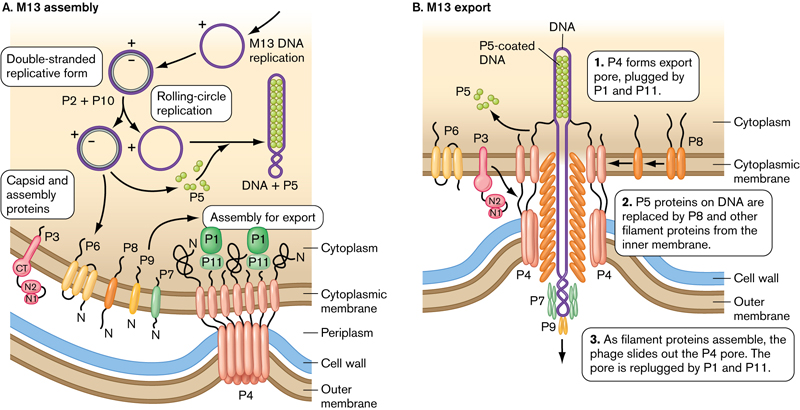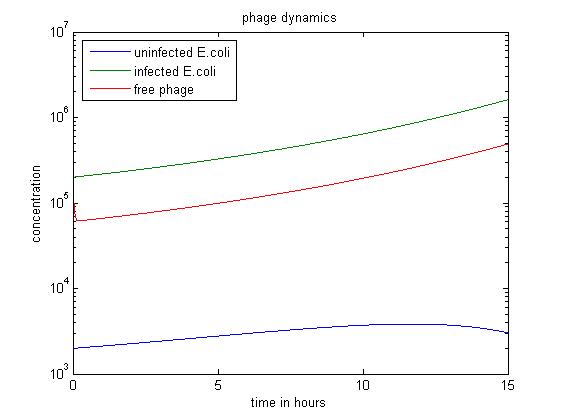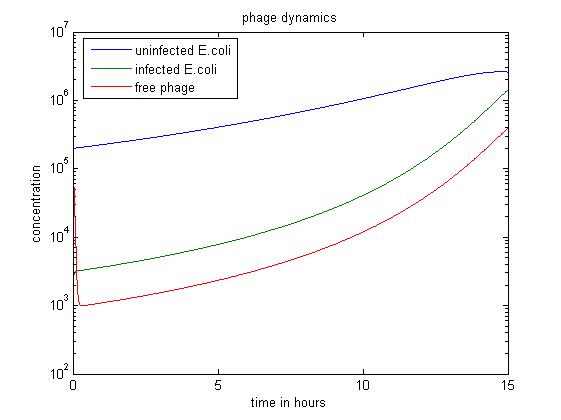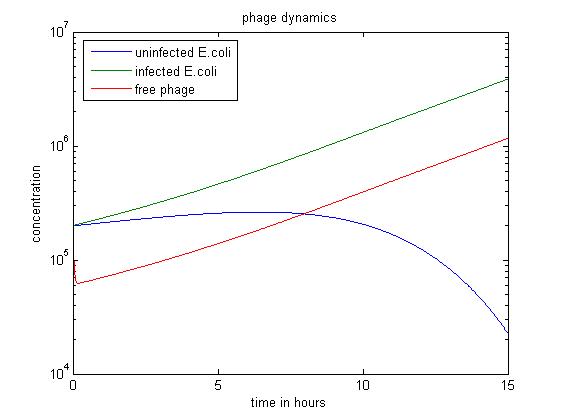Team:Edinburgh/Phage Replication
From 2011.igem.org
| Line 54: | Line 54: | ||
The [[:File:Matlab_code_phagerep.txt | MATLAB code]] uses a <span class="hardword" id="rk">Runge-Kutta method</span> of order four to solve the system. | The [[:File:Matlab_code_phagerep.txt | MATLAB code]] uses a <span class="hardword" id="rk">Runge-Kutta method</span> of order four to solve the system. | ||
| - | |||
| - | |||
| - | |||
| - | [[File:Phage dyn2.jpg|center|thumb|700px|caption|simulation value: x0=v0=2.00E5 y0=2.00E3]] | + | [[File:Phage dyn.jpg|center|thumb|700px|caption|Figure1 simulation value: x0=2.00E3 y0=v0=2.00E5]] |
| + | :The simulation runs under the condition that the amount of uninfected ''E.coli'' is significantly smaller than others.The quantity of uninfected ''E.coli'' keeps at a low level, which may have economical meaning in practical, since our goal is to get free displayed phage. Beside, the figure also shows the infected ''E. coli'' population dominates the population of free phage. | ||
| + | |||
| + | [[File:Phage dyn2.jpg|center|thumb|700px|caption|Figure2 simulation value: x0=v0=2.00E5 y0=2.00E3]] | ||
:The above figure shows a simulation going over 15 hours. | :The above figure shows a simulation going over 15 hours. | ||
:The simulation shows when the amount of infected ''E.coli'' is significantly smaller than others, the infected ''E. coli'' population dominates as well. | :The simulation shows when the amount of infected ''E.coli'' is significantly smaller than others, the infected ''E. coli'' population dominates as well. | ||
| - | [[File:Phage dyn3.jpg|center|thumb|700px|caption|simulation value: x0=y0=v0=2.00E5]] | + | [[File:Phage dyn3.jpg|center|thumb|700px|caption|Figure3 simulation value: x0=y0=v0=2.00E5]] |
Revision as of 11:41, 16 September 2011
Phage Replication
A basic activity in biorefinery consists of the degradation of cellulose, due to the presence of enzymes. We are not only concerned with the activities and the amount of enzymes, but also with metabolism and activities of bacteriophage.
Contents |
M13 Replication
M13 is a filamentous bacteriophage: a worm-like virus approximately 1 um long with a 10 nm diameter that infects only E.coli.
- The viral particle consists of a single-stranded, closed circular DNA core surround by a protein coat.
- Prior to virus assembly, the coat proteins are fixed in the bacterial membrane by transmembrane domains.
- During assembly, viral DNA is extruded through the membrane and concomitantly enveloped by coat proteins.
- The ends of the assembled virus are capped by four minor coat proteins, and the length of the filament is covered by several thousand copies of the major coat protein(P8).
- The M13 phage attacks E. coli (host), multiplies in the host cell cytoplasm, and is released without causing the bacteria’s death (non-lytic).
Phage dynamic model
At first thought, the rate of change of population = production rate of population - loss rate of population
Model for non lytic M13 phage
Equations
- dx/dt=a*k1*x-b*v*x
- Rate of change of quantity of uninfected E. coli equals to the uninfected E. coli replicate itself minus the E. coli infected by M13 phage.
- dy/dt=a*k2*y+b*v*x
- Rate of change of quantity of infected E. coli equals to the quantity of infected E. coli replicate itself plus the E. coli infected by M13 phage.
- dv/dt=c*y-b*v*x-m*v
- Rate of change of quantity of free phage equals to the phage released by infected E. coli minus the phage which is to infect an E. coli and the decayed phage.
- X(t) — uninfected E. coli
- Y(t) — infected E. coli
- V(t) — free phage
- a — replication coefficient of E. coli
- b — transmission coefficient of phage
- c — replication coefficient of phage
- m — decay rate of phage
- K1, K2 — account for the difference of the rate of replication between infected E.coli and uninfected E.coli
Simulations
The MATLAB code uses a Runge-Kutta method of order four to solve the system.
- The simulation runs under the condition that the amount of uninfected E.coli is significantly smaller than others.The quantity of uninfected E.coli keeps at a low level, which may have economical meaning in practical, since our goal is to get free displayed phage. Beside, the figure also shows the infected E. coli population dominates the population of free phage.
- The above figure shows a simulation going over 15 hours.
- The simulation shows when the amount of infected E.coli is significantly smaller than others, the infected E. coli population dominates as well.
In some cases a increase of the slope of decrease of uninfected E.coliis observed. This means probably that as the population of free phage increasing, more e.coli can be infected by phage.
References
- Gregory A. Weiss, Sachdev S. Sidhu(2000)[http://www.utoronto.ca/sidhulab/pdf/08.pdf: Design and Evolution of Artificial M13 coat Proteins]
- Slonczewski JL, Foster JW (2010) [http://www.wwnorton.com/college/biology/microbiology2/ch/11/etopics.aspx Microbiology: An Evolving Science], 2nd edition. W. W. Norton & Company
- Robert J.H Payne, Vincent A. A. Jansen(2011)[http://personal.rhul.ac.uk/ujba/115/jtb01.pdf Understanding Bacteriaphage therapy as a density-dependent kinetic process]
- Cattoen C (2003) [http://msor.victoria.ac.nz/twiki/pub/Groups/GravityGroup/PreviousProjectsInAppliedMathematics/bacteria-phage_REPORT.pdf Bacteriaphage mathematical model applied to the cheese industry]
- A.O. Converse, J.D. Optekar(1993) [http://onlinelibrary.wiley.com/doi/10.1002/bit.260420120/pdf: A synergistic Kinetics Model for Enzymatic Cellulose Hydrolysis Compared to degree-of-synergism Experimental Results]
- Kadam KL, Rydholm EC, McMillan JD (2004) [http://onlinelibrary.wiley.com/doi/10.1021/bp034316x/full: Development and Validation of a Kinetic Model for Enzymatic Saccharification of Lignocellulosic Biomass]
 "
"




